
Art Desiderata
Studio & Equipment
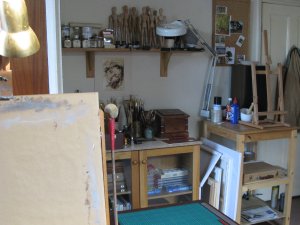
Fig 1 - General view of the studio.
Over the years I have worked in several environments, ranging from the kitchen table to the set up I now have, which is a room dedicated to the purpose of painting and all the ancillary activities that accompany it.
I like to fill this space with the paraphernalia of the artist, most of it useful, but some items serving no other purpose than to add to the required ambience of the studio, some of them being antiques.
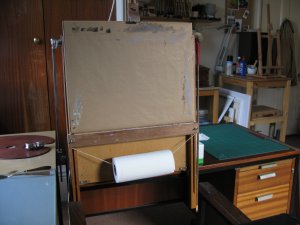
Fig 2 - Desk easel.
Although I have several easels, some shown later, my main studio easel is home made.
Basically it is a desk with the easel hinged to its top surface. The easel part is a drawing board to which is attached parts salvaged from an old tripod easel. It also has an arrangement for tilting the easel to any angle from flat to vertical ( this can be seen to the left of the image). This easel is versatile and can be used in a standing or sitting position and is extremely solid and stable.
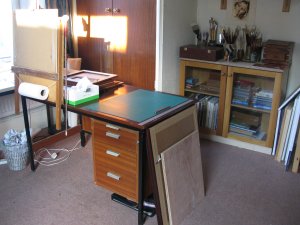
Fig 3 - Desk easel, wider view.
The window to left of picture is facing slightly west of north. What appears to be direct sunlight is actually reflected light from a building opposite, though direct sunlight can enter at the same angle but only late on a summer evening. The studio room does have another window facing approximately east of south.
Clearly there is no shortage of light but the strong lights are sometimes a problem, easily cured by the curtains.
A great advantage of this type of desk easel is the large surface area it provides. This can be used for storage or as an extra work surface when required. Also, the top desk drawer can be opened and used to hold equipment being used at the time. I use it for brushes.
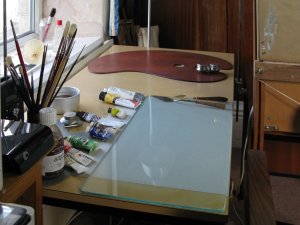
Fig 4 - Palette table.
I have my palette set up to my left where it receives good light from the window. I prefer to use a plate glass palette as seen above, rather than the traditional mahogany palette that can be seen in the background. The glass palette is so much easier to clean at the end of a painting session.
I have several mahogany or plywood palettes but would only use one if painting outdoors.
For the purpose of colour harmony I use a restricted palette consisting: Titanium White, Naples Yellow, Lemon Yellow, Burnt Sienna, Burnt Umber and French Ultramarine. These colours suffice for most landscape works with only the occasional addition of Sap Green and Cadmium Red.

Fig 5 - The Loxley Stirling Studio Easel.
This large capacity easel was my main studio easel before I modified a desk into a workstation easel as shown above.
This easel is suitable for working in a standing or sitting position and will accommodate very large paintings.
The recommended retail price for these easels is £140, but although this looked brand new when I bought it, I found it in an antique shop and haggled the asking price down to £60, a bargain at less than half price.
When this easel was in regular use I always worked standing and had a taboret (high table) by the side of it. The taboret can be seen behind and to the right of the image above and in other images below. As I now prefer to work in a sitting position this easel has been relegated to holding finished paintings.
Previous to this I used a Loxley Essex easel for a while before giving it to my son when he took up painting.
All my other easels are designed for outdoor use (or can be dual purpose) or pochade boxes. These are discussed below.

Fig 6 - French Box Easel.
Though primarily designed for outdoor use, or "Plein Air" painting, as it is called, these easels are dual purpose and can be utilised indoors if lack of space is a problem.
The French easel is a relatively modern design, so named because its inventor was a Frenchman named Roger Jullian. Jullian designed his sketch box easel to while away the time during his period as a prisoner of war in the Second World War. After the war he returned to France and formed the Jullian Company who still manufacture high quality easels today.
In my opinion this type of easel is quite heavy for lugging about, especially when crammed with the necessary materials that are required on a day out painting. There are better alternatives as discussed below.
For indoor use, where weight is not a problem they are a good choice where space is at a premium.
Regardless of my opinion about the weight the French design is the easel of choice for many artists who work out doors on a regular basis. I guess it is a matter of choice.

Fig 7 - The Yarka Easel (Russian).
Although there is still a Yarka company manufacturing artists' materials, as far as I can discover they no longer manufacture easels. These easels were available in the UK and Europe until the 1990s, but are no longer available. This is a pity because, in my opinion, for outdoor use they are superior to the French easel.
I prefer this design over the French easel for the following reasons:
The aluminium legs on the Yarka are lighter than wooden legs.
The box compartment on the model I have is smaller, hence lighter. Though they did make a larger box size.
Due to the canvas or board being mounted at the back of the box, rather than the front, as in the French design, there is no need for a drawer. Again making it lighter.
The Yarka can store a wet canvas inside the lid, rather than outside the lid as in the French design.
The Yarka has a unique design for holding the canvas that is far lighter than any other design of box easel.
As can be seen from the above this easel is a much lighter and more practical choice for lugging about on an outdoor painting trip. Lightness is the key when out and about with painting gear (see comments on pochade boxes below).

Fig 8 - French field easel variation.
"Half Box" field easel.
This is another new addition to my collection. The reason I acquired this was twofold: a) It is a design that I did not already possess, and b) I was interested in comparing the "half box" design with the Yarka easel mentioned above.
In terms of weight the half box design should be lighter. Not only is the easel approximately half the width of a full French easel, but it also has the advantage of having no lid (a folding palette acts as the lid), thereby, at least in theory, it should be lighter.
In practice I find the half French easel just as heavy as the full French easel, though I cannot see why. The Russian Yarka easel still wins hands down for lightness.
In the near future I shall dig out my fishing scales and weigh these field easels and resolve this issue.
There is no manufacturer's name on this easel but it is very well constructed and another great buy from ebay..
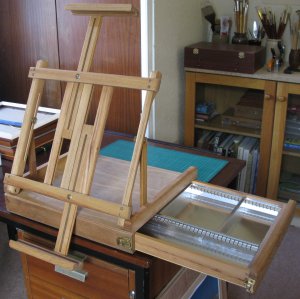
Fig 9 - Jullian Plein Air Travel Easel.
This easel is designed and marketed as the take anywhere easel, and is made to fit in the overhead hand luggage compartment of aircraft. Though if loaded with paint tubes and bottles of painting medium I very much doubt you would get aboard the aircraft with it under present circumstances.
As a matter of interest, Jullian manufacture their easels from birch wood as opposed to the more common choice of Elm. Their reason being, they argue, is that the thin pieces of wood, if made from elm, tend to split where they have been drilled or screwed. This, they claim, does not happen with birch.

Fig 10 - Pochade Box.
The pochade box was popular in the Victorian era but is now making a come back and is becoming increasingly popular with plein air painters. They can be lap held, tripod mounted or thumb boxes (see below). The pochade box shown in Fig 10 is one that is to some extent home made. I had a suitable box and modified it by the addition of a lid stay, "D" hinges for a shoulder strap and the attachement of a tripod adapter to its base. I intend to add a facility for holding a board.

Fig 11 - Small pochade box.
I woukd describe this as a pocket pochade box.
It will accommodate a standard 6" x 8" painting board.
The box itself is of a non-standard size. The board shown with the box is actually a 7" x 5" board.
It has a slide-out palette but has no facility for tripod mounting, though this can be easily rectified.
Manufacturer unknown.

Fig 12 - The Mendip Pochade box.
These were formally available from the Mendip Painting School, near Bristol, UK.
This box will hold two 10 inch by 8 inch panels in the lid. As can be seen from the photograph the pochade proper slides out of a lower compartment that in turn holds painting materials.
These pochade boxes have a thumb hole and are designed to be used either as a thumb box or lap box. This is a new addition to my collection and I have not had time to do anything with it yet. However, I intend to modify this box so that it can be attached to a camera tripod.


Fig 13 - The thumb box.
This is the pride of my modest collection of pochade boxes. It was manufactured by a French company called Bourgeois Aine (name stamped inside box).
After some research on the internet I have discovered that the Bourgeois Aine company ceased trading in 1910. Therefore, this box is well over a hundred years old, actual date unknown. It is of great interest to me that these boxes were in use at the time of the impressionist painters, and made in France, and could have been used by some of the great painters working at that time.
This was acquired on ebay from a seller resident in Jersey Shore, USA. His father, who was an artist, had passed away and this was among his possessions. The box looks as if it has never been used for its intended purpose as there is no paint staining on it at all, it is in pristine condition (I do not intend to use it either).
The box dimensions are 6 7/8" x 4 3/8" x 1 3/8" and it will accommodate two 6 1/2" x 4"panels in the slotted lid.